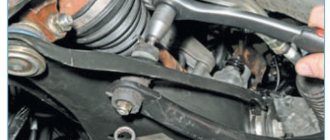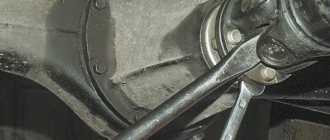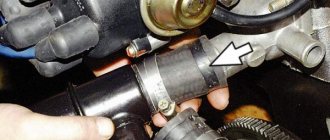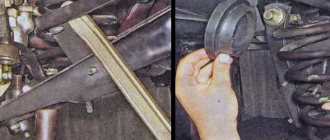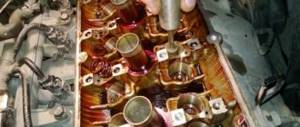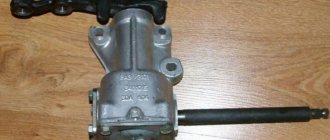The stabilizer bushing is an important part through which the stabilizer is mounted. During the operation of the car, the stabilizer bushings inevitably wear out and play occurs.
As a result:
- the operation of the stabilizer is disrupted;
- the car tilts when cornering;
- stability when braking deteriorates, etc.
For this reason, the condition of the stabilizer bushings must be monitored, and the front stabilizer bushings and rear stabilizer bushings must be changed in a timely manner. You can replace the bushings yourself. Read more in our article.
Why do you need a stabilizer and bushings?
The anti-roll bar is responsible for stabilizing the position of the car when cornering, as well as when the car brakes. Simply put, this stabilizer:
- eliminates lateral roll when cornering;
- reduces longitudinal roll when braking;
The main task of the stabilizer is to keep the car parallel to the road surface. The stabilizer itself is a simple rod connecting the subframe and the wheel mount (for example, a suspension arm on a MacPherson strut).
On a MacPherson-type suspension, the camber angle is static, but during roll this angle changes. In turn, this leads to the fact that the contact area of the tire with the road surface changes.
In order to maintain vehicle stability, roll must be reduced. To do this, a torsion bar is integrated into the design. In fact, the stabilizer performs the task of a torsion bar. If a lateral roll occurs, the ends of the rods located in the levers move in different directions.
This causes the middle part to curl. Moreover, such twisting is enough to reduce the roll when moving the wheels. This stabilizer can be installed on both the front and rear axles.
Stabilizer bushings
Stabilizer bushings (also called stabilizer bands) are extremely important for the normal operation of the torsion bar.
The fact is that the stabilizer must be able to twist under the influence of forces on the right and left wheels, and such forces are multidirectional.
This means that it is not possible to rigidly attach the rod to other parts. Taking into account the fact that the stabilizer should have a more “flexible” mount, the designers found another solution - the stabilizer is attached using special bushings.
Why are bushings used?
Novice car enthusiasts are naturally interested in why these same stabilizer bushings are needed on a car. The answer to this question is quite simple.
Let's start with what a stabilizer bushing is and where it is located on the car. This is the name given to the special elastic element used to connect the stabilizer itself to the body. You can call it a kind of gasket or intermediate element.
This immediately answers the question of where this element should be located and what it should be responsible for.
Bushings can directly influence the noise level generated by the suspension while driving and the stability of the vehicle.
The main feature is that the part is made of elastic materials. This is rubber or polyurethane. The use of such materials ensures that the suspension does not emit any extraneous sounds when the wheel height changes. You can imagine how the car would behave if the stabilizers were connected to the body directly, metal to metal.
Bushings serve as a connecting element between the suspension and the body. They are in constant interaction, and the bushing provides a certain margin for bending. The latter necessarily arises and changes the distance between the body and the stabilizer when going over bumps on the road.
To summarize, we can highlight the following functions of bushings:
- vibration damping;
- noise reduction;
- reliable fixation of body elements and suspension;
- ensuring smooth running.
Although this is a small part made of elastic material, its role in the design of the car is enormous. And a malfunction leads to dangerous possible consequences.
How the stub bushing works and why it wears out
In general, front stabilizer bushings or rear stabilizer bushings can be made from rubber or polyurethane by injection molding. The bushing may also have channels or bosses to increase service life and improve performance.
However, stabilizer bushings inevitably wear out and become damaged, resulting in play at the joints. This leads to the fact that the stabilizer begins to “dangle” and knock, while the part does not perform its functions.
In this case:
- the car handles worse, there is a noticeable wobble in the steering wheel (especially when the front stabilizer bushings are badly worn);
- vibrations appear, there may be creaks and knocks in the front or rear suspension;
- general stability is disrupted, deviations and deviations from straight-line motion are observed;
- roll in corners increases noticeably;
When do you need to change stabilizer bushings?
In practice, bushings are replaced every 30-40 thousand kilometers. In this case, it is better to change all the bushings at once, even if one fails.
It is optimal when the front or rear stabilizer bushings are replaced at the same time.
To more accurately understand when to change the stabilizer bushings, you must first clean them of dirt and carefully inspect them. The presence of cracks, tears, delamination of rubber, obvious abrasions, oval shape and other defects indicate that the bushings should be replaced.
At the same time, you should not drive with failed bushings and delay replacing them, since deterioration in controllability and stability can cause an accident. Also, severe destruction of the bushings can cause damage to other mating parts.
Stabilizer bushings. Signs of malfunction. Consequences.
For the best damping of vibration and force impacts on the car body, the vast majority of suspension elements are connected by means of elastic elements. The same applies to the stabilizer. To secure it, special bushings (rubber bands, cushions) made of durable rubber or polyurethane are used.
Over time, as the vehicle is used, these bushings may begin to deteriorate and noticeably lose their elasticity. The result of this is unsatisfactory operation of the stabilizer =. More serious defects may begin to appear, which will only grow faster over time.
The first symptom indicating replacement of the bushings will be a slight knocking sound from the suspension. A similar knock can be observed with “tired” shock absorbers. Only in the case of bushings it will be heard not only on potholes and potholes, but also when entering relatively sharp turns. At the same time, the car often feels excessively rolly and sluggish. The knocking sound that appears will be a consequence of play that has arisen in the connecting nodes of the stabilizer arms due to worn bushings.
If measures are not taken in time, the knocking will only intensify in the future and will begin to accompany the operation of the suspension everywhere due to increasing deformation and destruction of the bushings. Body roll and excessive play in the steering wheel may occur. The car may “yaw” not only when turning, but also when braking or changing lanes.
Most car manufacturers recommend changing stabilizer bushings every 30–40 thousand mileage. However, in our conditions it is better to focus on bushing wear. Therefore, a sudden knocking sound and slight rattling in corners will be clear signs of an impending component replacement.
As a popular method of checking the bushings for serviceability, it is proposed to drive the speed bump diagonally in 2nd gear. A dull knock appeared in the area of the pedals - most likely due to the hub bushings. You can also just crawl under the car and inspect everything yourself. A worn bushing will be pleased with the presence of cracks and abrasions characteristic of worn and cracked rubber. Auto mechanics sometimes also call these cracks “daisies.”
Also, the rubber of the bushings can simply harden and lose the necessary elasticity. If you can’t get a good look at the stabilizer bushings, just swing your hand strongly up and down and to the sides on the stabilizer itself. If you feel play, creaks and knocks in the lower part of the suspension, it means that the bushings have become unusable.
But for the best results, it is, of course, better to drive onto an overpass, an inspection hole, or use a lift. The only tools you will need are a crowbar or a mounting spade, which you simply need to rest against the bottom of the car and slightly “shake” the stabilizer where it connects to the body. If you feel noticeable play or loss of elasticity, then it’s time to think about replacing the bushings.
Replacing the stabilizer bushing: front and rear bushings
If the front stabilizer bushings are worn out, the rear stabilizer bushing is out of order, or the stabilizers do not work on the front and rear axles, all work on replacing the bushings can be done with your own hands in a regular garage.
To do this, you need to drive the car into a pit or lift it on a lift. You will also need a set of wrenches and a jack, penetrating lubricant.
- Having raised the car, the stabilizer bolts are treated with WD40 type lubricant;
- Next, the bolts are unscrewed, the stabilizer is moved away from the subframe with a crowbar or pry bar, and the clamp is removed;
- Then the rubber bushing of the stabilizer is removed;
- Before installing a new bushing, you must first lubricate the mounting hole;
- After installing a new bushing, you should also lubricate the clamp and bolt (in the future this will simplify the procedure for replacing bushings);
It should be taken into account that if the clamp cannot be put on the new bushing, no force should be applied. The fact is that a clamp can easily damage the rubber element.
In order to put the clamp on, you need to apply more silicone lubricant or soap solution to reduce friction between the rubber and metal. Having completed the replacement on one side, similar steps for replacing the stabilizer bushings are performed on the other. The main thing is not to damage the fuel pipes during the replacement process.
Let us add that by analogy with how the front stabilizer bushing is changed, the rear bushings can also be replaced. At the same time, it is easier to change the rear stabilizer bushings, since it is structurally easier to access them on many cars.
How to identify signs of wear on stabilizer bushings?
The occurrence of the following malfunctions during vehicle operation will indicate a malfunction of the stabilizer bushings:
- The first warning sign when the bushing fails will be the appearance of noise and knocking in the suspension when the car is moving. The difference from faults with shock absorbers will be that the suspension will knock not only when passing uneven surfaces, but also when entering turns with a small radius. Moreover, the road surface may be in good condition and not contain any unevenness;
- If you do not pay attention to the knocking sound in the suspension and continue to drive the car, the situation will begin to worsen. The noise in the suspension will increase and will be caused by any change in the position of the suspension. This will happen due to an increase in cracks and deformation of the stabilizer bushings;
- the next step will be the appearance of a large roll of the car when making turns with a small radius. The body will sway violently;
- In some cars, play in the steering wheel may occur. This is due to their design features;
- Further ignoring the situation will lead to the car's controllability deteriorating. The car may start to move from side to side when trying to make any maneuver.
You should not bring your car to this state, because this endangers not only your life, but also the safety of other road users.
Important! Most stabilizer bushings have a service life of 30 to 40 thousand kilometers. Do not exceed this figure and risk your safety.
If you do not have the opportunity to take the car to a service center for diagnostics, you can verify that the bushings are faulty on your own. To do this you need:
- find an overpass or pit for inspection. In this case, you should not use jacks or lifts. The fact is that the test will be accompanied by strong rocking of the car and strong physical impact on the stabilizer. Because of this, the car may lose stability and jump off these devices. At best, this can result in injury, at worst, death. Therefore, to ensure maximum safety, it is recommended to use overpasses and pits;
- Next, a visual assessment of the condition of the rubber bands is carried out. If any cracks or breaks are detected, such a part must be replaced;
- Next, you need to make a strong physical impact on the stabilizer. Tug it in different directions. Creaks and noise accompanying this action will indicate the need to replace the bushing.
If the stabilizer bushings creak after replacement
Typically, if the stabilizer bushings squeak, this indicates that the bushings are worn out and need to be replaced. However, you can often encounter the fact that it is the new bushings that begin to emit a characteristic creak after replacement.
In such a situation, creaking of the stabilizer bushings may occur at low temperatures or in hot and dry weather. The reason is obvious - drying out or poor quality of the bushing material. In this case, many owners try to solve the problem with silicone grease. Please note that it is not recommended to lubricate the stabilizer bushings!
We also recommend reading the article on how to change front and rear stabilizer links. From this article you will learn how to check the stub struts, as well as replace them if necessary.
The fact is that the lubricant quickly becomes contaminated, then grains of sand and dirt begin to act like an abrasive, abrading the bushing and damaging the stabilizer itself. Also, lubricated bushings soften and do not hold the stabilizer so tightly. It turns out that the reliability of fastening is reduced.
Basic recommendations in this case:
- installation of higher quality bushings;
- after replacement, you need to drive 200-300 km so that the bushings get used to it;
If the creaking does not disappear, you can also try replacing the rubber bushings with polyurethane analogues. However, some experts do not recommend installing such bushings! You can also try wrapping the part of the stabilizer that goes into the bushing with electrical tape, cloth or thin rubber. This will allow the stabilizer to be fixed more tightly inside the bushing and will reduce the likelihood of squeaking.
What tools may be needed when replacing stabilizers yourself?
Performing this work will not require the driver to use high-tech devices. To do this you need to have the following tools:
- jack;
- extension for key;
- socket wrench for 10 and 13;
- ruler;
- socket heads for 13 and 14. Preferably elongated;
- ratchet wrench.
This is the minimum required set of tools, without which you definitely cannot carry out repairs. However, you may need an additional set. This need may arise when removing the fastening nuts. The fact is that during operation they can stick to the part. In this case, you may need a grinder or a hacksaw. You need to use these tools very carefully, because you can damage the stabilizer links. If this happens, then you will need to change them too.
Recommendations
- For replacement, either the original front or rear stabilizer bushing or an analogue can be used.
Taking into account the fact that the service life of even original parts is not long, it is not necessary to purchase expensive new stabilizer bushings. At the same time, you should not take the cheapest solutions either, since low quality rubber can cause squeaks. We also recommend reading the article on how to bleed shock absorbers before installing them on a car. From this article you will learn why pumping is needed, as well as how to perform this procedure correctly. - If the bolts securing the stabilizer cannot be unscrewed, they must be cut off with a grinder or the clamp ear cut off on both sides.
It is important not to damage the fuel pipes. In this case, the tubes will have to be removed, additionally protected, or moved to the side. Some manufacturers offer stabilizer bushings with boots. These anthers help protect the inner surface of the bushing from water, dirt and dust. If possible, purchasing and installing such bushings would be the best solution. - The inner surface of the bushing must be lubricated exclusively with lubricants that do not have a negative effect on the rubber. As a rule, these are universal silicone lubricants. In this case, it is better to purchase lubricant from a reputable manufacturer.
